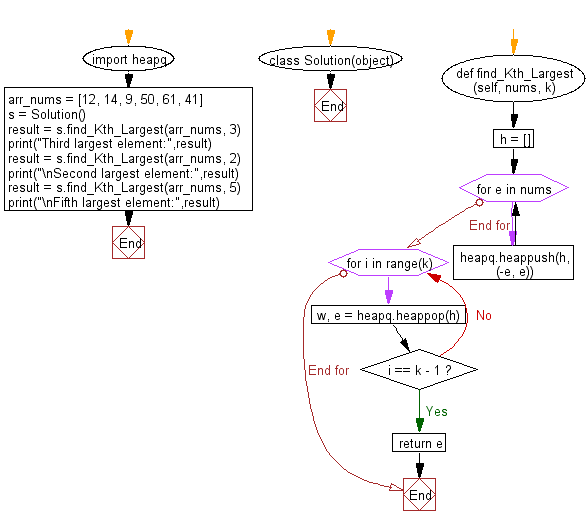Python: Find the kth largest element in an unsorted array using Heap queue algorithm
Python heap queue algorithm: Exercise-7 with Solution
Write a Python program to find the kth (1 <= k <= array's length) largest element in an unsorted array using Heap queue algorithm.
Sample Solution:
Python Code:
import heapq
class Solution(object):
def find_Kth_Largest(self, nums, k):
"""
:type nums: List[int]
:type of k: int
:return value type: int
"""
h = []
for e in nums:
heapq.heappush(h, (-e, e))
for i in range(k):
w, e = heapq.heappop(h)
if i == k - 1:
return e
arr_nums = [12, 14, 9, 50, 61, 41]
s = Solution()
result = s.find_Kth_Largest(arr_nums, 3)
print("Third largest element:",result)
result = s.find_Kth_Largest(arr_nums, 2)
print("\nSecond largest element:",result)
result = s.find_Kth_Largest(arr_nums, 5)
print("\nFifth largest element:",result)
Sample Output:
Third largest element: 41 Second largest element: 50 Fifth largest element: 12
Flowchart:

Visualize Python code execution:
The following tool visualize what the computer is doing step-by-step as it executes the said program:
Python Code Editor:
Have another way to solve this solution? Contribute your code (and comments) through Disqus.
Previous: Write a Python program to sort a given list of elements in ascending order using Heap queue algorithm.
Next: Write a Python program to compute maximum product of three numbers of a given array of integers using Heap queue algorithm.
What is the difficulty level of this exercise?
Test your Programming skills with w3resource's quiz.
Python: Tips of the Day
Find current directory and file's directory:
To get the full path to the directory a Python file is contained in, write this in that file:
import os dir_path = os.path.dirname(os.path.realpath(__file__))
(Note that the incantation above won't work if you've already used os.chdir() to change your current working directory, since the value of the __file__ constant is relative to the current working directory and is not changed by an os.chdir() call.)
To get the current working directory use
import os cwd = os.getcwd()
Documentation references for the modules, constants and functions used above:
- The os and os.path modules.
- The __file__ constant
- os.path.realpath(path) (returns "the canonical path of the specified filename, eliminating any symbolic links encountered in the path")
- os.path.dirname(path) (returns "the directory name of pathname path")
- os.getcwd() (returns "a string representing the current working directory")
- os.chdir(path) ("change the current working directory to path")
Ref: https://bit.ly/3fy0R6m
- New Content published on w3resource:
- HTML-CSS Practical: Exercises, Practice, Solution
- Java Regular Expression: Exercises, Practice, Solution
- Scala Programming Exercises, Practice, Solution
- Python Itertools exercises
- Python Numpy exercises
- Python GeoPy Package exercises
- Python Pandas exercises
- Python nltk exercises
- Python BeautifulSoup exercises
- Form Template
- Composer - PHP Package Manager
- PHPUnit - PHP Testing
- Laravel - PHP Framework
- Angular - JavaScript Framework
- Vue - JavaScript Framework
- Jest - JavaScript Testing Framework
